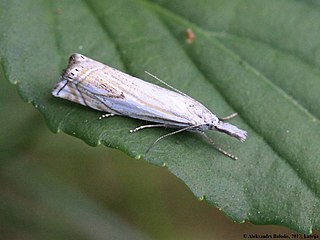Related Research Articles

Ptycholoma lecheana, the Leche's twist moth, is a moth of the family Tortricidae. It is found in Europe, China, Korea, Japan, Russia and Asia Minor.

Agonopterix arenella is a species of moth of the family Depressariidae. It is found in all of Europe, except the Iberian Peninsula.

Agonopterix ocellana is a species of moth of the family Depressariidae. It is found in Europe and was first described by Johan Christian Fabricius in 1775

Agonopterix angelicella is a moth of the family Depressariidae. It is found in most of Europe, except the Iberian Peninsula and south-eastern Europe. It is also found on the Russian plain and Siberia and in Japan.

Leucoptera laburnella is a moth in the family Lyonetiidae. It is found in most of Europe, except the European part of Russia and the southern part of the Balkan Peninsula. It is also found in North America.
Depressaria douglasella is a moth of the family Depressariidae. It is found in most of Europe.
Caryocolum tricolorella is a moth of the family Gelechiidae. It is found from Fennoscandia to the Pyrenees, Alps and Romania and from Ireland to Russia and Ukraine.

Aproaerema anthyllidella is a moth of the family Gelechiidae. It is found in most of Europe, Kyrgyzstan, Iran and North America.

Bucculatrix demaryella is a moth of the family Bucculatricidae. The species was first described by Philogène Auguste Joseph Duponchel in 1840. It is found in most of Europe, Russia and Japan.

Crambus uliginosellus is a species of moth in the family Crambidae. It was first described by Zeller in 1850 and is currently found in most of Europe, except Portugal, Slovenia, Croatia and Ukraine.

Ichneutica scutata is a moth of the family Noctuidae. It is endemic to New Zealand. This species can be found in the southern parts of the North Island as well as the eastern parts of the South Island. It is similar in appearance to I. insignis and I. skelloni but can be distinguished as I. scutata is much paler in appearance. It is likely this species inhabits lowland tussock grasslands as well as coastal dunes although it is not common in inland tussock grasslands. The larvae feed on a variety of herbaceous plants such as Plantago and Convolvulus species, Plagianthus divaricatus. It pupates on soil near its host plants. The adults are on the wing from late March to July.
Dichomeris squalens is a moth in the family Gelechiidae. It was described by Edward Meyrick in 1914. It is found in Guyana and Brazil.
Xenolechia ceanothiella is a moth of the family Gelechiidae. It is found in North America, where it has been recorded from California.
Commatica emplasta is a moth in the family Gelechiidae. It was described by Edward Meyrick in 1914. It is found in Guyana and Peru.
Ethirostoma semiacma is a moth in the family Gelechiidae. It was described by Edward Meyrick in 1914. It is found in Guyana.
Battaristis stereogramma is a moth of the family Gelechiidae. It was described by Edward Meyrick in 1914. It is found in Guyana.
Cophomantella artonoma is a moth in the family Lecithoceridae. It was described by Edward Meyrick in 1936. It is known from the Democratic Republic of the Congo.
Neospastis calpidias is a moth in the family Xyloryctidae. It was described by Edward Meyrick in 1917. It is found in southern India.
Neospastis encryphias is a moth in the family Xyloryctidae. It was described by Edward Meyrick in 1907. It is found in India (Assam).

Epinotia abbreviana is a moth of the family Tortricidae. It is found in Europe and was first described by Johan Christian Fabricius in 1794.
References
- ↑ Savela, Markku, ed. (January 19, 2015). "Neospastis ichnaea (Meyrick, 1914)". Lepidoptera and Some Other Life Forms. Retrieved September 7, 2020.
- ↑ Meyrick, E. (1906). "Descriptions of Indian Microlepidoptera: Part XVIII". Journal of the Bombay Natural History Society. 23 (1): 118. Retrieved 16 June 2020– via Internet Archive.
 This article incorporates text from this source, which is in the public domain .
This article incorporates text from this source, which is in the public domain .